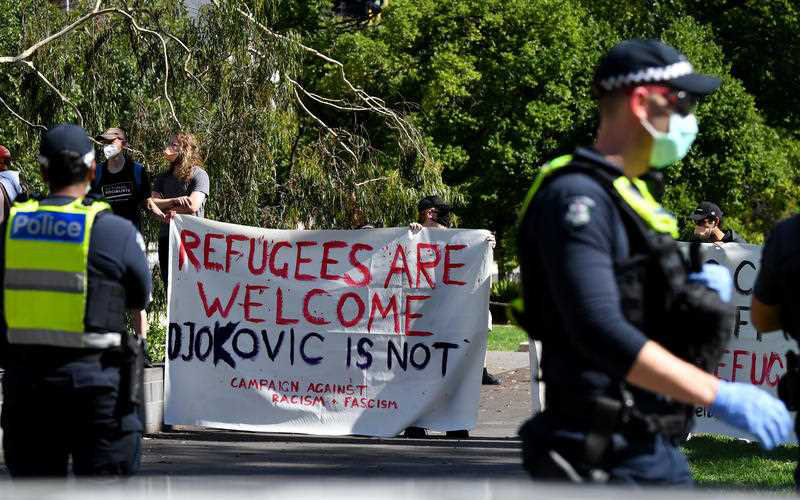Long-term immigration detention has again become a pointless exercise in cruelty
Jan 22, 2022
The Howard government released long-term detainees into the community, but the current Coalition government refuses to do so for political reasons.
Novak Djokovic’s few days at the Park Hotel in Carlton briefly shone light on the ongoing horrific plight of long-term immigration detainees.
The most publicised case at the Park Hotel was that of Mehdi, a 24-year-old refugee who had been in one form of immigration detention or another for nine years since the age of 15. However, he, and the luckless people who have spent years locked up in the now notorious Carlton hotel, were quickly forgotten by the media as soon as Djokovic was out of the country.
It is interesting to reflect that the full Federal Court was specially convened on a Sunday to allow a wealthy tennis player who had spent just a few days in immigration detention to pursue his case to remain in Australia. But no such action has occurred for the refugees, stateless persons, asylum seekers and others who have spent years in immigration detention.
There is a strong sense of déjà vu about the current situation. The Howard government allowed a situation to develop where there was a caseload of long-term immigration detainees. These were mostly, but not always, asylum seekers who had arrived by sea. The most notable was Peter Qasim, who had been detained for seven years. A rigid policy enshrined in the Migration Act meant that people without a right to remain in Australia either left the country or stayed in detention indefinitely, even though it might be quite impracticable for them to return to their home country.
Under pressure from Liberal moderates, led by Petro Georgio, Howard in 2005 accepted the need to do something about the folly and cruelty of keeping people in immigration detention for year after year when their cases could not be effectively progressed.
The Department of Immigration came up with a new visa tool — a specialised bridging visa — and a new ministerial power (both of which were legislated) to give the government more legal flexibility to get people out of detention. The Howard government was then able to progressively use these tools to get long-term detainees into the community. This didn’t necessarily mean that the individuals were permitted to stay permanently in Australia or given access to a wide range of benefits. It was simply that the outstanding matters they had with the Australian government could be resolved while they were living in the community.
Around that time there was also the scandal of Cornelia Rau, an Australian permanent resident who was wrongly held in immigration detention for months. Several external reviews, including one by former Australian Federal Police commissioner Mick Palmer, reflected on the damage to the mental health of detainees and how desensitised the system had become to the use of extraordinary powers to detain people.
Following the election of the Rudd Labor government in 2007, immigration minister Chris Evans introduced reforms to allow the department to continue to pursue its legitimate immigration compliance role, but with much less use of detention. The scope for different forms of detention, including community detention outside of formal institutions, was expanded.
So how is it that we are back in a similar situation of overuse of immigration detention and a caseload of long-term detainees? With the return of a Coalition government under Tony Abbott in 2013, a much harsher approach to the use of detention was progressively reintroduced under the new Department of Immigration and Border Protection and, subsequently, the Department of Home Affairs. The lessons of the Howard years were forgotten.
According to Department of Home Affairs statistics, in September 2021 there were 1459 people in closed immigration detention — 510 of them had spent more than two years in detention and 117 had spent more than five years. Reputedly, a small number have been in detention for over 10 years. The detainees are a mixed bunch ranging from maritime refugees, asylum seekers, stateless persons and visa overstayers through to people whose visas were cancelled on character grounds.
Why are they in detention at all? The actual policy purpose of immigration detention has always been to briefly hold people, such as asylum seekers arriving by sea, for identification, health checks and application processing. It is also used to assist in the removal of people unlawfully in Australia who may be at risk of absconding from the immigration authorities.
None of this is a justification for incarcerating people for years simply because the legal power exists and their cases have not been resolved. It just becomes a pointless exercise in cruelty. No purpose whatsoever is advanced by holding people in detention for such a long time if their case is not being effectively progressed either towards the granting of a visa or removal from Australia. If a person’s case has not been resolved in three, four or up to 10 years, it is unlikely that keeping them in detention any longer will help. And for the budget minded, immigration detention is expensive for the taxpayer.
The Morrison government should urgently review the situation of long-term detainees. It should start with those who have been detained for over two years with a view to releasing them into the community. The tools that were created under the Howard government still exist. The priority should be to get the longest-term detainees, people found to be refugees, stateless persons and other vulnerable cases out into the community as soon as possible. Other types of cases in long-term detention should be reviewed progressively. Some of them will be more difficult, such as those whose visas have been cancelled on character grounds or who have a qualified/adverse security assessment. There is nearly always a non-detention solution if you want there to be one. Release into the community may or may not come with a longer-term visa, depending on the individual situation.
Sadly, based on practice to date, it is hard to see any of this happening. The Morrison government appears to be locked into the position of showing how tough it can be on asylum seekers who arrived by sea and those migrants whose visas have been cancelled. Tired mantras are used about deterrence and the imminent risks of further boat arrivals if the slightest sensible compassion is shown towards long-term asylum seeker detainees. So we are led to believe that if asylum seekers in detention in Australia (or in offshore processing centres) are facilitated in being resettled in the United States, there will be no pull factor for further maritime asylum seekers, but the same logic does not apply to releasing someone into the Australian community, even on a very restricted visa. It doesn’t add up.
It is likely that in the run-up to the election the government will be happy to leave the current cruel status quo in place in order to show its toughness. Resolving the problem in a humane way will be a job for a potential Labor government.




